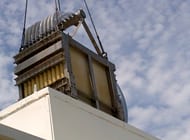Anaergia Hybrid-Membrane Technology Selected for Water Reuse Projects in California
- January 20, 2014
- Anaergia Admin

Burlington, Ontario, January 20, 2014 – Anaergia Inc., today announced that the Victor Valley Wastewater Reclamation Authority (VVWRA) has selected FibrePlate™ hybrid-membrane™ technology for two sub-regional Membrane Bioreactor (MBR) facilities. The MBR facilities will be located in high growth areas of the service region and produce a combined two million gallons per day of high quality effluent for landscape irrigation.
In addition to providing a drought-proof supply of water, the sub-regional MBR facilities will reduce the overall load on the collection system, enabling VVWRA to defer costly infrastructure expansion and reduce the energy costs associated with pumping recycled water.
“This is a critical project that will help to ensure the future sustainability and economic prosperity of our communities,” said Logan Olds, General Manager of Victor Valley Wastewater Reclamation Authority. “We have a proven track record of employing best-in-class technologies to help solve critical wastewater infrastructure challenges. FibrePlate™ represents a new generation of membrane technology that offers unique operational efficiencies including future capacity expansion capabilities for the VVWRA.”
“We are honored to have been selected for these MBR projects by the VVWRA,” said Andrew Benedek, Executive Chairman and Chief Technology Officer of Anaergia. “FibrePlate™ membranes are a game changing technology and they are the first 100% newly designed membrane that the industry has seen in a long time. The hybrid-membrane™ combines the best advantages of hollow-fibre and flat-sheet technologies to deliver a significant capital and operating cost advantage to our clients.”
Compared to conventional water reuse processes, the MBR facilities will have a small footprint and each facility will be architecturally designed to blend with the local community. The FibrePlate™ membrane technology at the core of the MBR system will provide a positive, ultrafiltration barrier that will ensure a reliable, high quality reuse effluent at all times.
FibrePlate™ hybrid-membrane™ technology offers several unique benefits to MBR facility owners and operators. The technology combines the best advantages of hollow-fibre membranes including high packing density and a backwash capability with the low trans-membrane pressure and ease of operation of flat sheet membranes. The result is a significant reduction in capital and operating cost and exceptional operating flexibility for new or existing MBR facilities planning membrane replacements.
“VVWRA and Anaergia share a common long-term vision of bringing best-in-class solutions to convert wastewater and other organic waste streams into sustainable resources,” said Steve Watzeck, CEO of Anaergia Inc. “The FibrePlate™ hybrid-membrane™ technology is a great addition to our global portfolio of leading solutions that recover value from waste.”
The FibrePlate™ membrane is manufactured by Fibracast Inc., a global leader in the research, development and production of advanced membrane technologies for water and wastewater treatment. Fibracast is an Anaergia associated company.
About Anaergia
Anaergia is a global leader in recovering value from waste for the municipal, industrial, and agriculture sectors worldwide. Through its proven portfolio of proprietary technology, Anaergia’s integrated solutions create value for its customers in the forms of clean water, renewable energy and quality fertilizers while dramatically reducing costs of waste management. Anaergia’s international headquarters are located in Burlington, Ontario, Canada, with regional services through 14 offices located in Europe, North America and Asia. Anaergia subsidiaries and affiliates include UTS Biogastechnik in Europe and Pharmer Engineering as well as The Stover Group in the United States. Anaergia technologies are in use at over 1,600 anaerobic digestion plants worldwide, reducing greenhouse gas emissions while creating new revenue sources for our client partners.
UNISCITI A NOI NELLA LOTTA AL CAMBIAMENTO CLIMATICO
Contattaci per discutere di come possiamo aiutare la tua azienda o comunità a trasformare i suoi rifiuti organici in energia rinnovabile.
